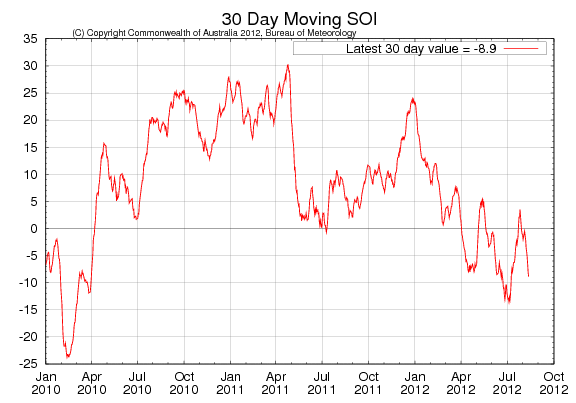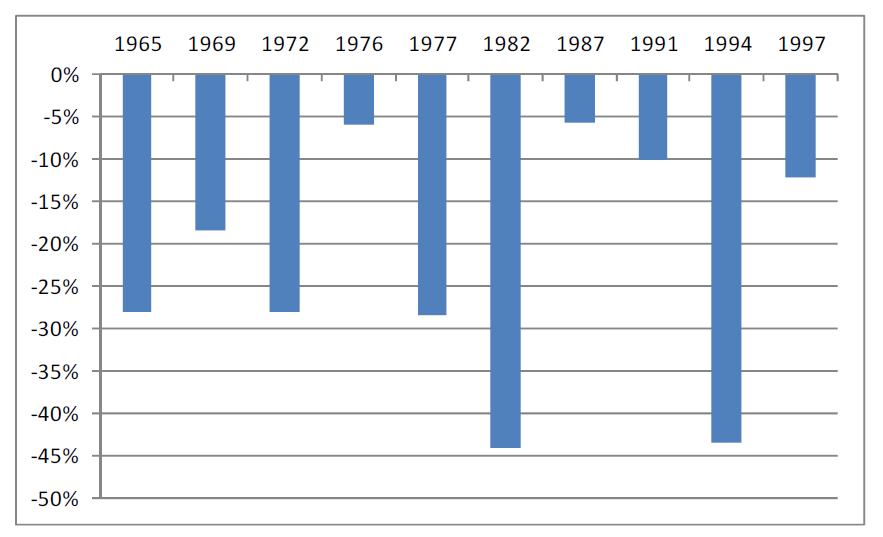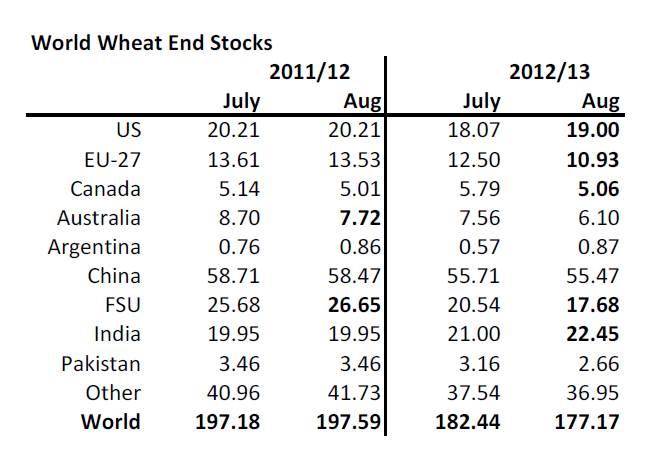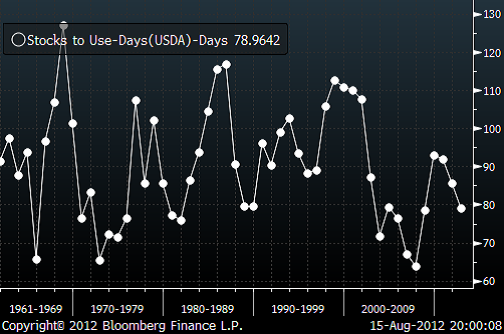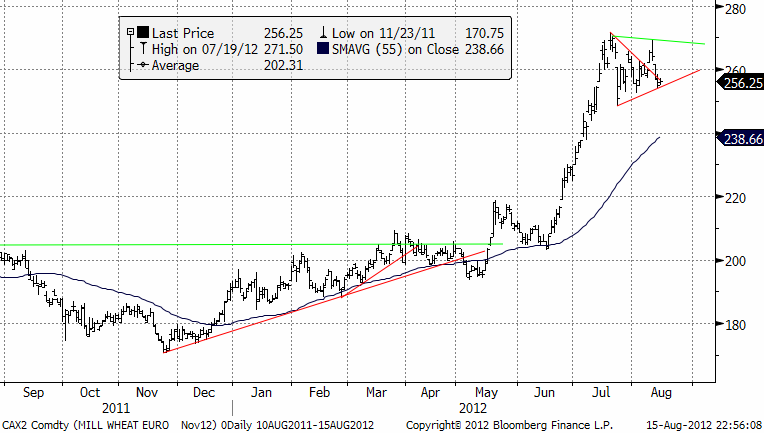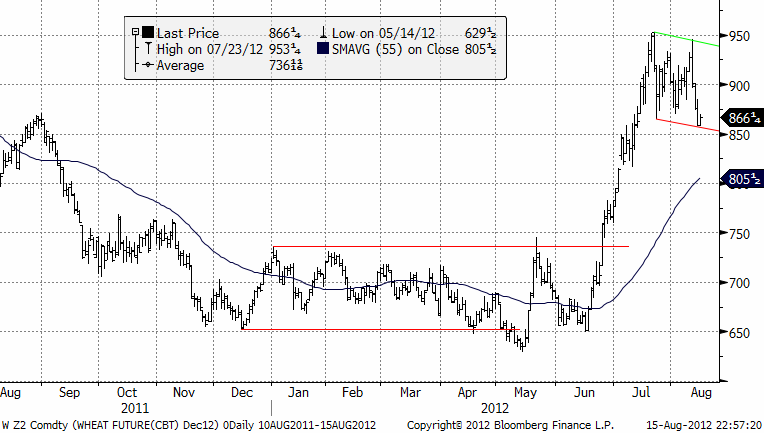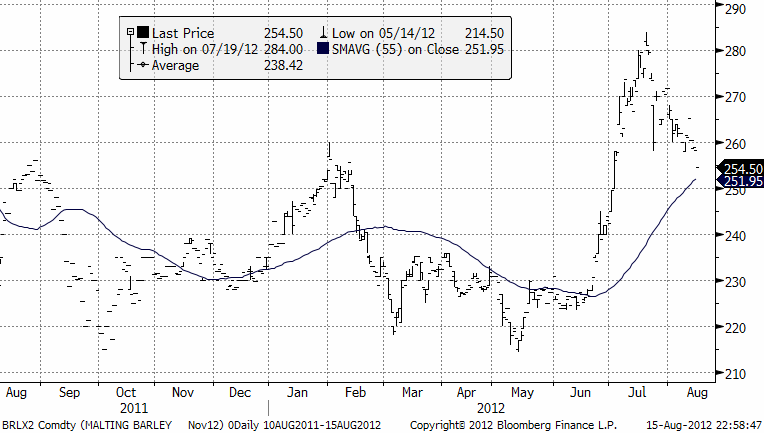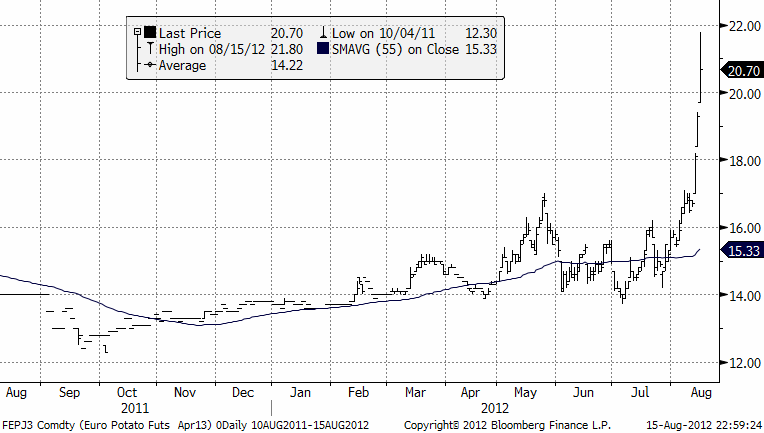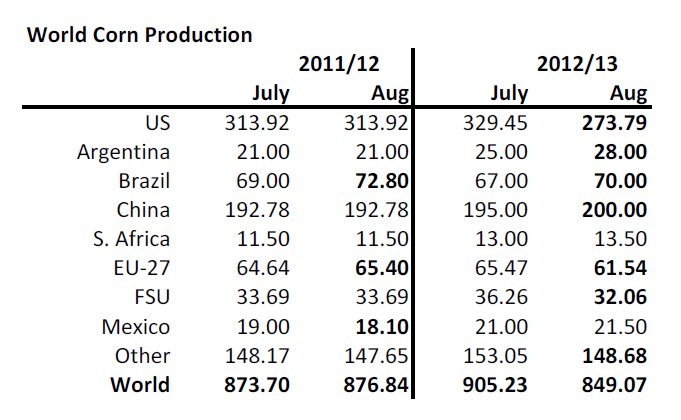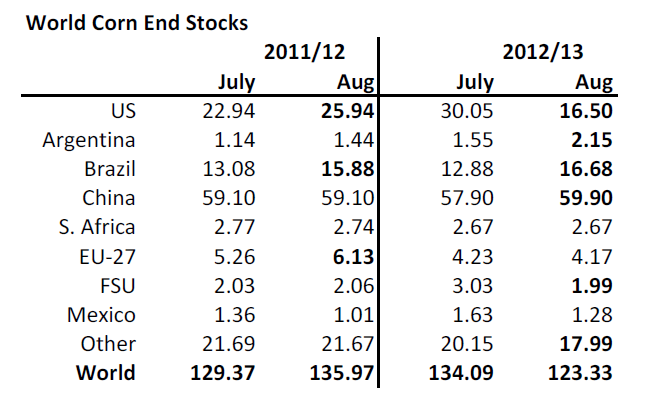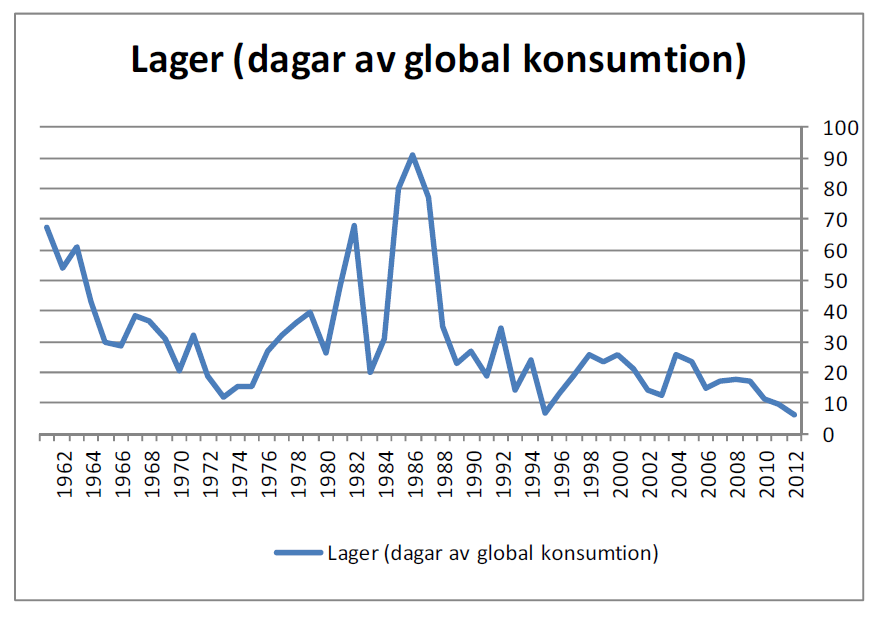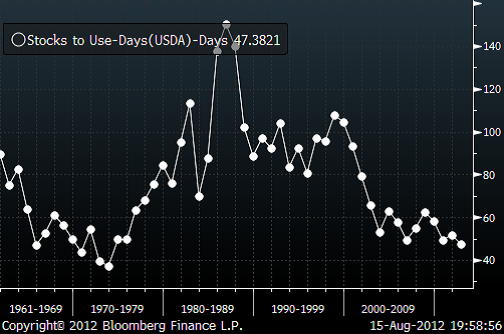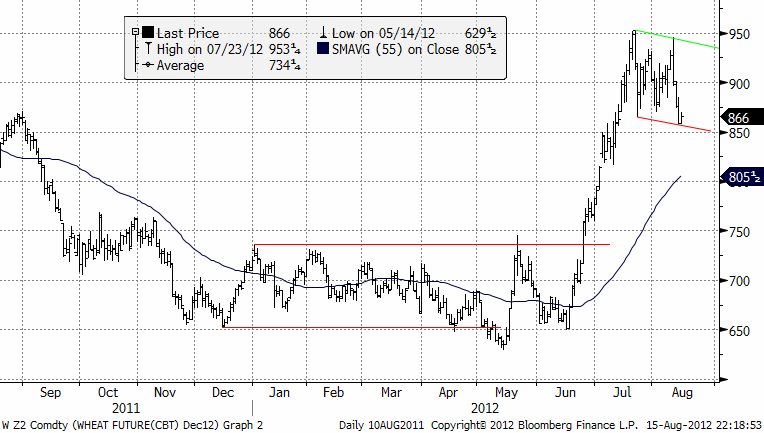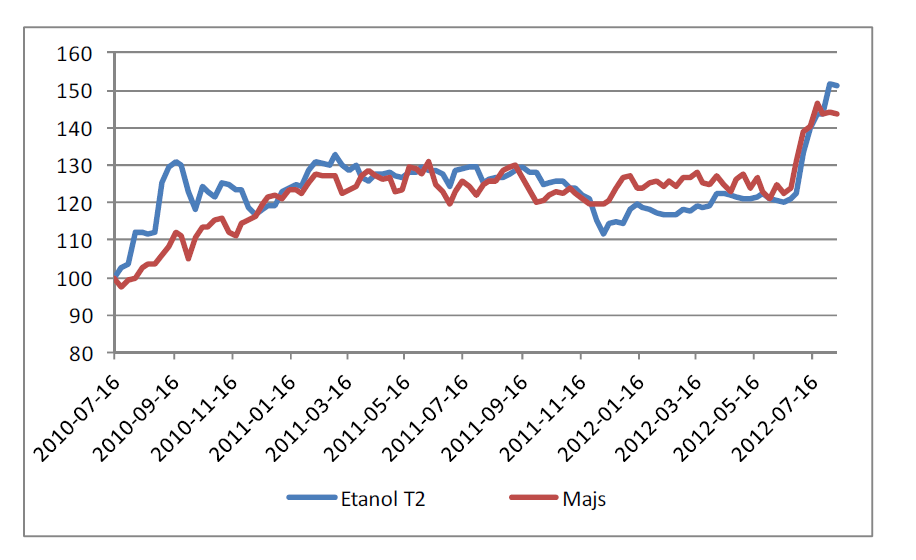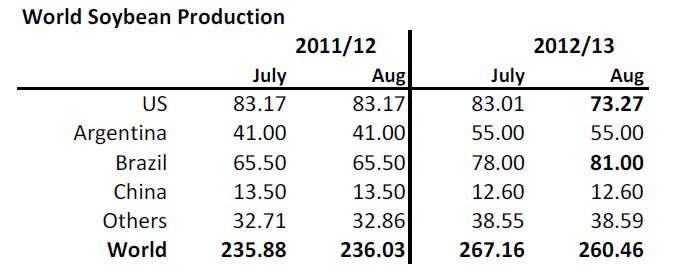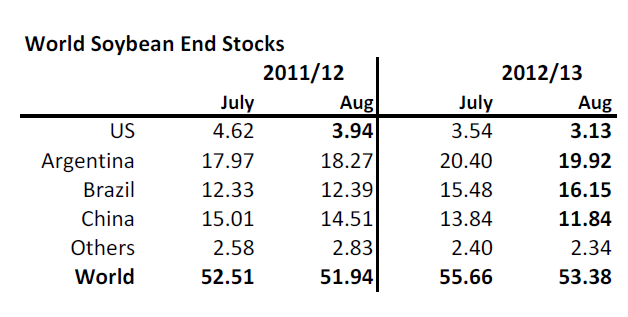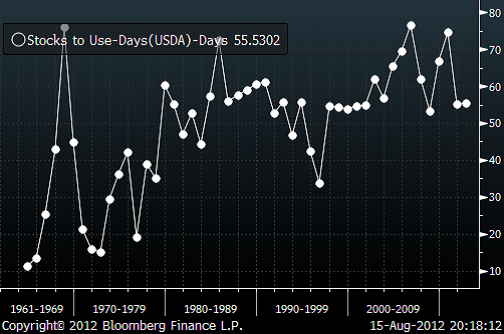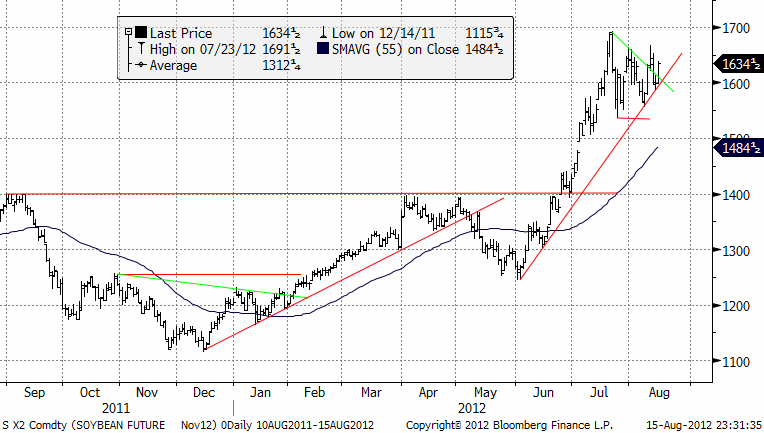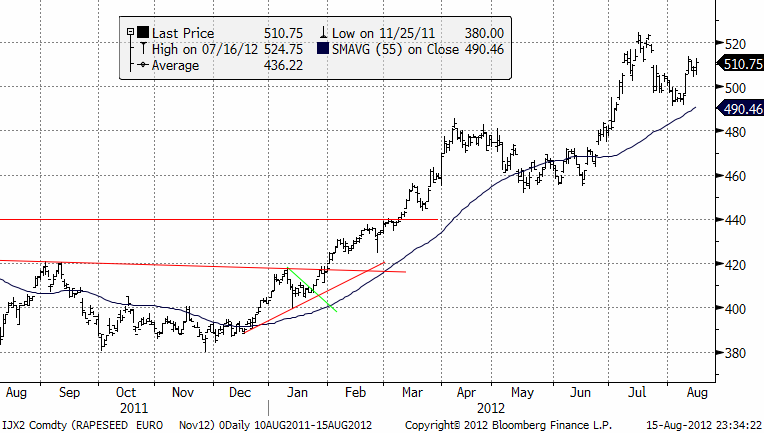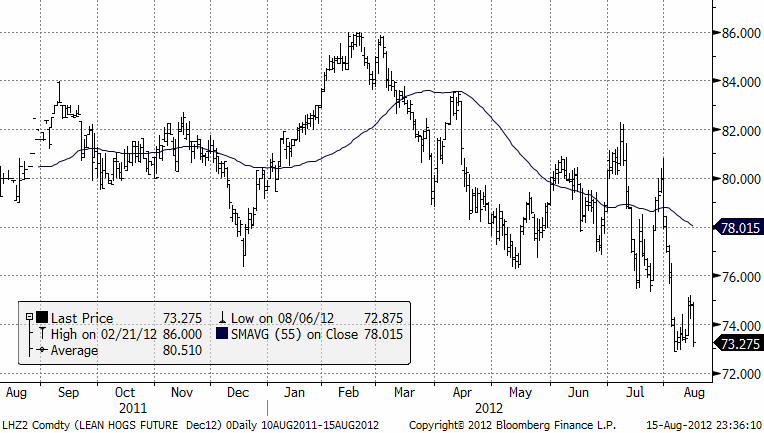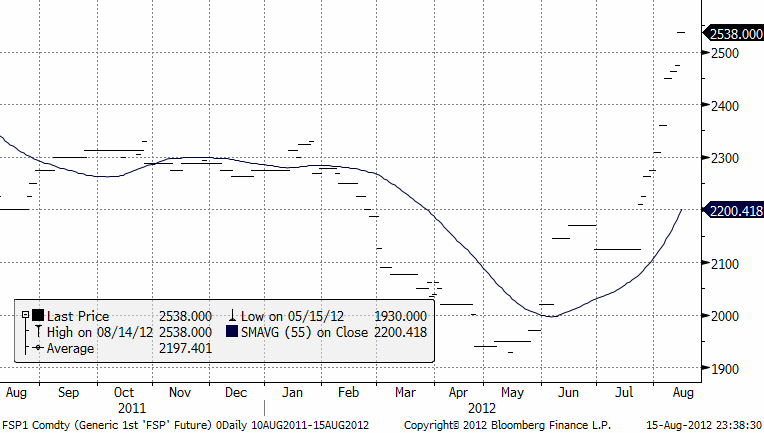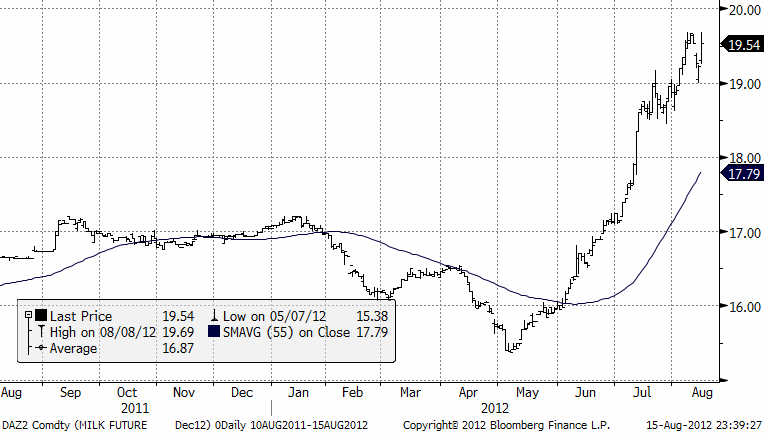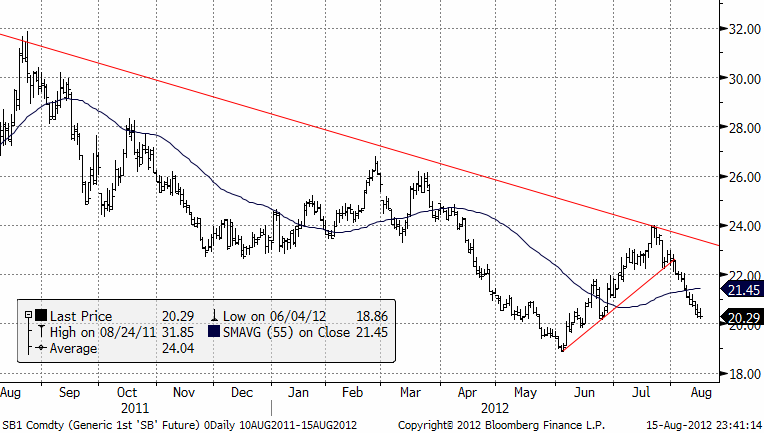Analys
SEB Jordbruksprodukter, 16 augusti 2012
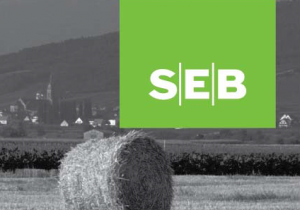 Fredagens WASDE-rapport var ”OK” för vete och sojabönor, men USDA:s prognos för utbud och efterfrågan i majs visar rekordlåga lager och vi tror inte att man tagit hänsyn till de produktionsbortfall som kunnat tas hänsyn till. Priset måste ransonera konsumtionen mycket. Risken är på uppsidan. Att priset ändå inte gick upp ordentligt beror på att EPA/USDA efter WASDE-rapporten i fredags erkände att man ”tittar på” att minska etanolanvändningen. Regn under helgen fick också sojabönspriset att mjukna.
Fredagens WASDE-rapport var ”OK” för vete och sojabönor, men USDA:s prognos för utbud och efterfrågan i majs visar rekordlåga lager och vi tror inte att man tagit hänsyn till de produktionsbortfall som kunnat tas hänsyn till. Priset måste ransonera konsumtionen mycket. Risken är på uppsidan. Att priset ändå inte gick upp ordentligt beror på att EPA/USDA efter WASDE-rapporten i fredags erkände att man ”tittar på” att minska etanolanvändningen. Regn under helgen fick också sojabönspriset att mjukna.
Ett politiskt beslut som leder till minskade stöd till etanolproduktion med majs skulle kunna få priserna att falla. Vi vet alldeles för lite än så länge om den här processen, men behåller tills vidare vår positiva vy på prisutvecklingen för majs, och därmed för vete och oljeväxter också.
Priset på potatis för ny skörd har på tre dagar stigit från 17 euro per dt till 20.70 euro. Potatishaussen är alltså det mest spännande vi har att berätta om den här veckan.
”The Duke brothers” som på 80-talet försökte klämma åt apelsinjuicemarknaden i filmen ”Ombytta roller” (Trading places), har nu fått en ny marknad. Idag är tredje dagen man kan handla frystkoncentrerad äppeljuice, på MGEX.
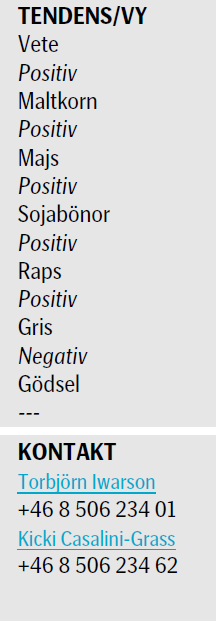 Nu har vi lagt till terminspris-tabeller för EUREX mjölkpulver och Amerikansk klass 3 flytande mjölk som handlas på CME, längst bak i det här brevet.
Nu har vi lagt till terminspris-tabeller för EUREX mjölkpulver och Amerikansk klass 3 flytande mjölk som handlas på CME, längst bak i det här brevet.
Odlingsväder
”Renewed development towards El Niño” skrev Australian Bureau of Meteorology den 14 augusti. De skriver att utvecklingen mot El Niño avtog under juli, men att utvecklingen har tagit ny fart de senaste två veckorna. Deras klimatmodeller indikerar nu att El Niño-förhållanden uppnås innan september är slut. Southern Oscillation Index (SOI) har återigen fallit och ligger nu på -8.1. Ett värde på mellan -8 och +8 indikerar neutrala ENSO-förhållanden, medan ett värde under -8 indikerar El Niño. Flera andra faktorer, såsom t ex högre temperatur vattnet i mellersta Stilla Havet pekar i samma riktning, en återkomst av El Niño. El Niño innebär generellt sett torrt och varmt väder i Australien och Sydostasien, och fuktigt väder i Sydamerika. Australien producerar mycket vete, medan Sydamerika producerar mindre vete, mindre i år än vanligt pga Kirschners konfiskatoriska skatt av argentiska veteodlare. Däremot producerar Sydamerika mycket sojabönor och mycket majs, och socker. För världen väger Sydamerikas fördelar mycket tyngre än Australiens nackdelar.
Vete
WASDE-rapporten i fredags visade precis som väntat lägre produktion. Produktionen var till och med lägre än väntat.
För USA och Kanada justerades produktionen upp något lite. Även Indien justerades upp. EU justerades ner en gnutta, liksom Argentina (på lägre areal). Ryssland justerades ner 6 mt, vilket antagligen INTE är tillräckligt, som vi skrev för ett par veckor sedan. Med 30% lägre hektarskörd, såsom siffrorna nått oss, innebär en total spannmålsskörd på 66 mt, inte 75 – 80 som Rysslands jordbruksministerium säger. Man lämnar Australiens förutspådda skörd oförändrad, förmodligen för att man inte visste något säkert om El Niño när man gjorde rapporten. Vi har sett ovan att det är mycket troligt att det kommer att vara El Niño innan slutet av september. USDA har justerat ner hektarskörden från förra året med 6% och då var förra årets hektarskörd långt över trenden. Det ligger alltså väldigt lite El Niño-effekt i siffrorna från USDA. Nedan ser vi förändringen i hektarskörd för vete i Australien från året innan, för de år då det varit El Niñoförhållanden den 30 september.
Jag har valt att identifiera El Niño med SOI < -8 per 30 september. Om vi nu tänker på att USDA endast har justerat ner förra årets hektarskörd med 6% för Australien, och vi tänker att det borde vara närmare genomsnittet de senaste 50 åren, -22%, så kan vi räkna lite. Skörden förra året i Australien var 29.5 mt. USDA har den till 26 mt i år. USDA räknar då med 6% lägre areal också. Låt oss anta att det är så och så sänker vi hektarskörden med 22% istället för 6%. Då hamnar vi på 21.5 mt. Det är alltså 4.5 mt lägre och alltså 4.5 mt lägre globala carry out stocks, eftersom detta skulle ha exporterats. Nedan ser vi USDA:s idé om carry out stocks:
Vi tror att utgående lager kommer att reduceras ytterligare. Lagren är inte akut låga i ett historiskt perspektiv. Problemet i världen är inte vete, utan majs. Nedan ser vi utgående lager enligt USDA:s prognos i förhållande till global konsumtion (i antal dagar av konsumtion).
Matifvetet med novemberleverans har fortfarande en ”bullish” triangel. Priset ”brukar” bryta upp vid sådana mönster.
Nedan ser vi Chicagovetet med leverans i december. Den tekniska bilden indikerar samma sak här, men antyder snarare att ytterligare trendlös ”sidledes” rörelse är mest sannolik.
Maltkorn
Novemberkontraktet på maltkorn ligger i en nedgångsfas som har stora likheter med vad som i efterhand ofta identifieras som en rekyl inför en ny, kraftig prisuppgång. Nedgången från förra veckan är 4 euro per ton.
Potatis
Potatispriset bröt intervallet när 17 euro bröts och det genererade en teknisk köpsignal. Säljarna klev bort från 17. Det fick priset att på tre dagar gå upp från 17 euro per dt till 21.80 som högst för att igår stänga på 20.70.
Majs
Nedanför ser vi USDA:s produktionsestimat. Sedan julirapporten har de justerat ner produktionen med 55 mt. Man har höjt produktionen med 6 mt för Brasilien + Argentina, vilket inte är orimligt om man tar hänsyn till El Niño (vilket de dock inte gjorde för veteproduktionen i Australien). Före detta Sovjetunionen har man antagligen sänkt för lite.
Nedan ser vi utgående lager. USDA har skurit bort 750 miljoner bushels i foderefterfrågan i USA. Dessutom har man sänkt åtgången till etanolproduktion med 400 mbu och 300 mbu i lägre export. Det tar ner utgående lager för USA från 30 till 16.5 mt.
I termer av USA:s konsumtion, är det den näst lägsta nivån på 50 år. 1996 var det en fraktion lägre. Ser vi dock USA som försörjaren av mat till världsmarknaden, och vi jämför utgående lager i USA med global konsumtion, så är det den lägsta lagernivån på 50 år (så långt bakåt vi har data). Vi ser ett diagram över detta nedan.
USA:s lager räcker till 6 dagar av global konsumtion. Som vi ser i diagrammet ovan ”slår” det 1995, då lagren räckte i 6.55 dagar. 1973 är ett annat lågvattenmärke. Då bottnade lagren på 12 dagar. 1973 är året för ”the Great Grain Robbery”, då Sovjetunionen råkade ut för torka och i hemlighet dammsög världsmarknaden på spannmål, innan missväxten blev känd. Det var så pass allvarligt att USDA ansåg sig behöva inrätta FAS. FAS är Foreign Agricultural Service. Det är tack vare FAS vi har så bra statistik på globalt utbud och efterfrågan som publiceras genom WASDE-rapporterna. Det lite skrämmande att inse att situationen just nu alltså är värre än 1973 när vi ser på det på det här sättet. Men det kanske inte är fullt lika illa, därför att Argentina och framförallt Brasilien har klivit in som stora producenter för världsmarknaden vid sidan av USA.
Globala utgående lager i termer av global konsumtion ser vi nedan. Det är lågt även där. Det mest väsentliga för världsmarknadspriset är emellertid inte vad som finns i t ex Kina, utan vad som kan komma ut på världsmarknaden. Störst relevans för världsmarknadspriset har situationen i USA.
Nedanför ser vi prisutvecklingen för spotkontrakten på sojabönor, vete och majs. Vi ser att världen inte egentligen har ett veteproblem, utan ett sojabönsproblem och framförallt ett majsproblem. Majs är ett mycket sämre spannmål än vete och kan inte gärna bli dyrare än vete, eftersom man då kommer att substituera majs med vete i foderblandningar. Därmed blir världens majsproblem ett veteproblem.
Måndagens crop ratings visade att majs i visade en ökning på 1% i kategorin very poor, till 26%. Förra året var det 5%. Good och Excellent var oförändrade på 20% och 3%. Priset på decembermajs har även den senaste veckan rört sig ”sidledes”, trots all ”action” i fredags vid WASDE-rapporten.
I fredags bekräftade EPA / USDA att man ”tittade på” etanolmandatet. Vi skrev för ett par veckor sedan om att Frankrike kallat in ett nytt G20-möte om matkrisen. Jag hade trott att de återigen skulle försöka anklaga ”investerare” eller ”spekulanter” för att ha drivit upp priset (i strid mot bättre vetande). Men det verkar som om fokus kommer att vara på etanolproduktion av spannmål. I en artikel i måndagens Financial Times rapporteras också om att FN vill att man på G20-mötet ska försöka begränsa produktionen av etanol med spannmål som råvara. För bara några få år sedan var det just samma FN som krävde mer etanolproduktion med spannmål.
Att majspriset hänger ihop med priset på etanol ser vi lätt i nedanstående diagram, där båda serierna börjar på 100 och anpassade med hedge-ratiot mellan etanol och majs.
Vad politikerna i USA och i G20 kommer fram till har klivit in på höstens scen som en central faktor för prisutvecklingen. Om de beslutar sig för att minska subventionerna för etanol och spara såväl pengar i sina skuldtyngda statsbudgetar, säkert lockande, och återigen ”rädda planeten”, kan de få spannmålspriset att falla kraftigt. Ironiskt nog håller EU nu på att reglera råvaruterminsmarknaden för att hindra spekulanter att orsaka volatilitet, en anklagelse som enhälligt avvisats av alla från IMF, OECD och FAO till akademia. Det är verklighetens ironi, att det nu är politikerna själva som orsakar volatiliteten på marknaden. Det är i och för sig inget ovanligt. Vi har tidigare visat hur exportstopp och prisregleringar införs av politiker när priset stiger. Genom detta får de priset på världsmarknaden att stiga ännu mer. Men hur troligt är det att Obama ett valår fattar ett politiskt beslut som ger redan bedrövade amerikanska bönder ett lägre pris på vad de nu lyckas skörda? Indiens foderindustri har begärt att exporten av majs ska förbjudas omedelbart pga den dåliga produktionen i spåren av den dåliga monsunen. Processen med exportstopp är definitivt startad nu. På en vecka har marknaden glömt frågan om Ryssland kommer att införa exportstopp. Den faktorn är trots allt alltjämt aktuell.
Priset ”borde” gå upp på den rekorddåliga skörden, men den politiska etanolfrågan vet vi för lite om än så länge. Med viss tvekan behåller vi vår köprekommendation.
Sojabönor
Väderleksprognosen för de närmaste tio dagarna innehåller en hel del regn och kallare temperaturer för relevanta sojabönsområden i USA. Men bönorna är å andra sidan ca 3 veckor tidiga i sin utveckling mot normalt. Enligt måndagens crop report sätter 83% av sojabönorna baljor nu, mot 64% förra året. Andelen i good / excellent condition ökade 1% till 30%. Produktionsestimaten i fredagens WASDE-rapport ser vi nedan.
Det är en stor sänkning för USA och en ökning för Brasilien. Enligt detta är Brasilien nu världens största producent av sojabönor. Argentina har just höjt exportskatten på biodiesel från 20% till 32%. Nedan ser vi utgående lager. USA ligger rekordlågt, liksom på majs.
Tack vare Brasilien ligger globala lager inte lågt i ett historiskt perspektiv, som vi ser i nedanstående diagram som visar utgående globala lager i termer av dagar av konsumtion. Argentina har också stora lager, men med den kortsiktiga och destruktiva jordbrukspolitik som landets president bedriver är det svårt att se hur Argentina ska kunna växa enligt sin potential.
Nedan ser vi kursdiagrammet på sojabönor med leverans i november. Sojabönor har rört sig sidledes precis som majs och vete. Om något pekar trenden fortsatt uppåt.
Raps
Priset på novemberterminen befinner sig alltjämt i en obruten uppåtgående trend. 500 som var ett starkt stöd, bröts för en vecka sedan, men köpare dök upp på 490 nivån. Trenden uppåt är intakt och det är möjligt att marknaden ska upp och testa toppen från juli igen.
Gris
Decemberkontraktet på lean hogs som bröt under stödet på 76 cent, rekylerade upp till detta (ett säljtillfälle) och har nu återtagit prisfallet.
Mjölk
Priset på mjölkpulver i Nordeuropa har fortsatt att stiga ännu en vecka. Priset har ökat 4% från 2450 euro per ton till 2538.
På den amerikanska börsen, har priset rört sig sidledes, liksom majsen och sojan. Trenden är dock uppåtriktad och 20 cent är en psykologiskt viktig ni pga att det är en så jämn siffra. Säkerligen ligger det en del ”take profit” / prissäkringsordrar där.
Socker
Priset på socker har, såsom vi har förutspått, fortsatt att sjunka. 20 cent är en psykologiskt viktig nivå. Möjligen kan det komma en rekyl på den nivån, men trenden på lite längre sikt är nedåtriktad.
[box]SEB Veckobrev Jordbruksprodukter är producerat av SEB Merchant Banking och publiceras i samarbete och med tillstånd på Råvarumarknaden.se[/box]
Disclaimer
The information in this document has been compiled by SEB Merchant Banking, a division within Skandinaviska Enskilda Banken AB (publ) (“SEB”).
Opinions contained in this report represent the bank’s present opinion only and are subject to change without notice. All information contained in this report has been compiled in good faith from sources believed to be reliable. However, no representation or warranty, expressed or implied, is made with respect to the completeness or accuracy of its contents and the information is not to be relied upon as authoritative. Anyone considering taking actions based upon the content of this document is urged to base his or her investment decisions upon such investigations as he or she deems necessary. This document is being provided as information only, and no specific actions are being solicited as a result of it; to the extent permitted by law, no liability whatsoever is accepted for any direct or consequential loss arising from use of this document or its contents.
About SEB
SEB is a public company incorporated in Stockholm, Sweden, with limited liability. It is a participant at major Nordic and other European Regulated Markets and Multilateral Trading Facilities (as well as some non-European equivalent markets) for trading in financial instruments, such as markets operated by NASDAQ OMX, NYSE Euronext, London Stock Exchange, Deutsche Börse, Swiss Exchanges, Turquoise and Chi-X. SEB is authorized and regulated by Finansinspektionen in Sweden; it is authorized and subject to limited regulation by the Financial Services Authority for the conduct of designated investment business in the UK, and is subject to the provisions of relevant regulators in all other jurisdictions where SEB conducts operations. SEB Merchant Banking. All rights reserved.
Analys
Brent crude inching higher on optimism that US inflationary pressures are fading


Brent crude price inching higher on optimistic that US inflationary pressures are fading. Brent crude closed up 1.1 USD/b ydy to a close of USD 86.39/b which was the highest close since the end of April. This morning it is trading up another half percent to USD 86.9/b along with comparable gains in industrial metals and Asian equities. At 14:30 CET the US will publish its preferred inflation gauge, the PCE figure. Recent data showed softer US personal spending in Q1. Expectations are now high that the PCE inflation number for May will show fading inflationary pressures in the US economy thus lifting the probability for rate cuts later this year which of course is positive for the economy and markets in general and thus positive for oil demand and oil prices. Hopes are high for sure.
Brent crude is trading at the highest since the end of April
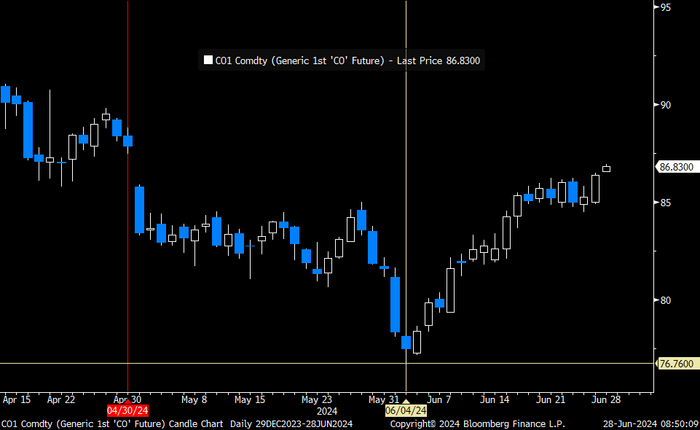
The rally in Brent crude since early June is counter to rising US oil inventories and as such a bit puzzling to the market.
US commercial crude and oil product stocks excluding SPR.

Actual US crude oil production data for April will be published later today. Zero growth in April is likely. Later today the US EIA will publish actual production data for US crude and liquids production for April. Estimates based on US DPR and DUC data indicates that there will indeed be zero growth in US crude oil production MoM in April. This will likely driving home the message that there is no growth in US crude oil production despite a Brent crude oil price of USD 83/b over the past 12 mths. The extension of this is of course rising expectations that there will be no growth in US crude oil production for the coming 12 months either as long as Brent crude hoovers around USD 85/b.
US production breaking a pattern since Jan 2014. No growth at USD 83/b. What stands out when graphing crude oil prices versus growth/decline in US crude oil production is that since January 2014 we have not seen a single month that US crude oil production is steady state or declining when the Brent crude oil price has been averaging USD 70.5/b or higher.
US Senate looking into the possibility that US shale oil producers are now colluding by holding back on investments, thus helping to keep prices leveled around USD 85/b.
Brent crude 12mth rolling average price vs 4mth/4mth change in US crude oil production. Scatter plot of data starting Jan 2014. Large red dot is if there is no change in US crude oil production from March to April. Orange dots are data since Jan 2023. The dot with ”-1.3%” is the March data point.
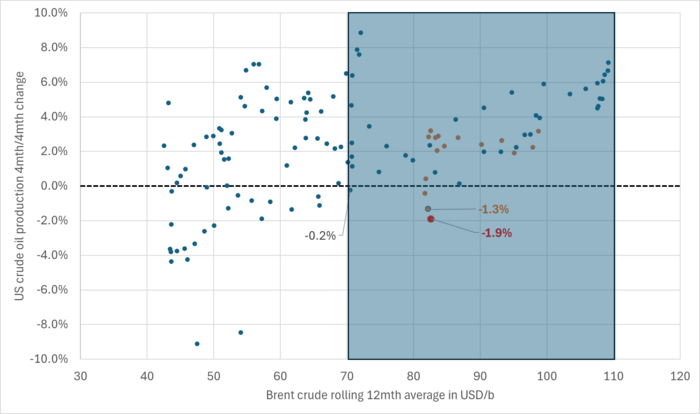
Brent crude 12mth rolling average price vs 4mth/4mth change in US crude oil production. Data starting Jan 2014. The last data point is if there is no change in US crude oil production from March to April.
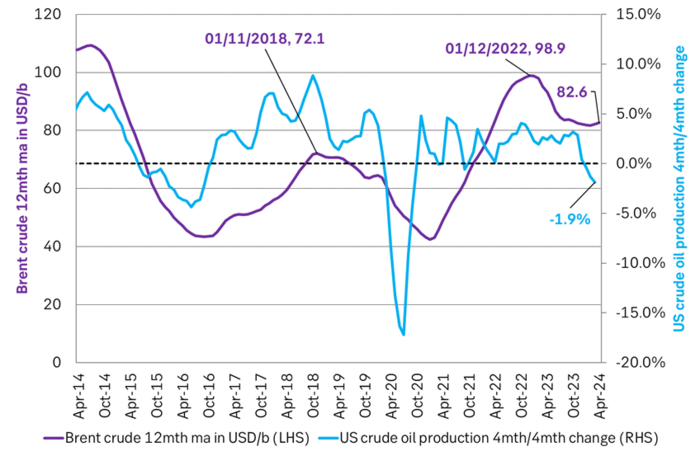
Analys
Price forecast update: Weaker green forces in the EU Parliament implies softer EUA prices


We reduce our forecast for EUA prices to 2030 by 10% to reflect the weakened green political agenda in the EU Parliament following the election for the Parliament on 6-9 June. The upcoming election in France on 7 July is an additional risk to the political stability of EU and thus in part also to the solidity of the blocks green agenda. Environmental targets for 2035 and 2040 are most at risk of being weakened on the margin. EUA prices for the coming years to 2030 relate to post-2030 EUA prices through the bankability mechanism. Lower post-2030 climate ambitions and lower post-2030 EUA prices thus have a bearish impact on EUA prices running up to 2030. Actual softening of post-2030 climate ambitions by the EU Parliament have yet to materialize. But when/if they do, a more specific analysis for the consequences for prices can be carried out.
EUA prices broke with its relationship with nat gas prices following the EU Parliament election. The EUA price has dutifully followed the TTF nat gas price higher since they both bottomed out on 23 Feb this year. The EUA front-month price bottomed out with a closing price of EUR 50.63/ton on 23 Feb. It then reached a recent peak of EUR 74.66/ton on 21 May as nat gas prices spiked. Strong relationship between EUA prices and nat gas prices all the way. Then came the EU Parliament election on 6-9 June. Since then the EUA price and TTF nat gas prices have started to depart. Bullish nat gas prices are no longer a simple predictor for bullish EUA prices.
The front-month EUA price vs the front-year TTF nat gas price. Hand in hand until the latest EU Parliament election. Then departing.
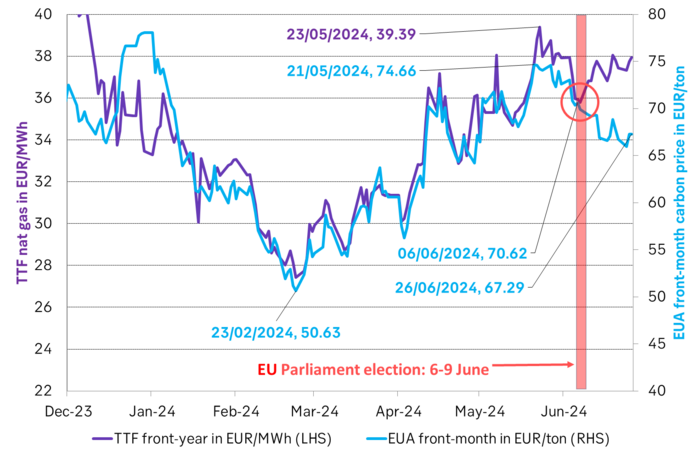
The EU Parliament election on 6-9 June was a big backlash for the Greens. The Greens experienced an euphoric victory in the 2019 election when they moved from 52 seats to 74 seats in the Parliament. Since then we have had an energy crisis with astronomic power and nat gas prices, rampant inflation and angry consumers being hurt by it all. In the recent election the Greens in the EU Parliament fell back to 53 seats. Close to where they were before 2019.
While green politics and CO2 prices may have gotten a lot of blame for the pain from energy prices over the latest 2-3 years, the explosion in nat gas prices are largely to blame. But German green policies to replace gas and oil heaters with heat pumps and new environmental regulations for EU farmers are also to blame for the recent pullback in green seats in the Parliament.
Green deal is still alive, but it may not be fully kicking any more. Existing Green laws may be hard to undo, but targets for 2035 and 2040 will be decided upon over the coming five years and will likely be weakened.
At heart the EU ETS system is a political system. As such the EUA price is a politically set price. It rests on the political consensus for environmental priorities on aggregate in EU.
The changes to the EU Parliament will likely weaken post-2030 environmental targets. The changes to the EU Parliament may not change the supply/demand balance for EUAs from now to 2030. But it will likely weaken post-2030 environmental targets and and thus projected EU ETS balances and EUA prices post-2030. And through the bankability mechanism this will necessarily impact EUA prices for the years from now to 2030.
Weaker post-2030 ambitions, targets and prices implies weaker EUA prices to 2030. EUA prices are ”bankable”. You can buy them today and hold on to them and sell them in 2030 or 2035. The value of an EUA today fundamentally rests on expected EUA prices for 2030/35. These again depends on EU green policies for the post 2030 period. Much of these policies will be ironed out and decided over the coming five years.
Weakening of post-2030 targets have yet to materialize. But just talking about it is a cold shower for EUAs. These likely coming weakenings in post-2030 environmental targets and how they will impact EUA prices post 2030 and thus EUA prices from now to 2030 are hard to quantify. But what is clear to say is that when politicians shift their priorities away from the environment and reduce their ambitions for environmental targets post-2030 it’s like a cold shower for EUA prices already today.
On top of this we now also have snap elections in the UK on 4 July and in France on 7 July with the latter having the potential to ”trigger the next euro crisis” according to Gideon Rachman in a recent article in FT.
What’s to be considered a fair outlook for EUA prices for the coming five years in this new political landscape with fundamentally changed political priorities remains to be settled. But that EUA price outlooks will be lowered versus previous forecasts is almost certain.
We reduce our EUA price forecast to 2030 by 10% to reflect the new political realities. To start with we reduce our EUA price outlook by 10% from 2025 to 2030 to reflect the weakened Green agenda in the EU parliament.
SEB’s EUA price forecast, BNEF price forecasts and current market prices in EUR/MWh
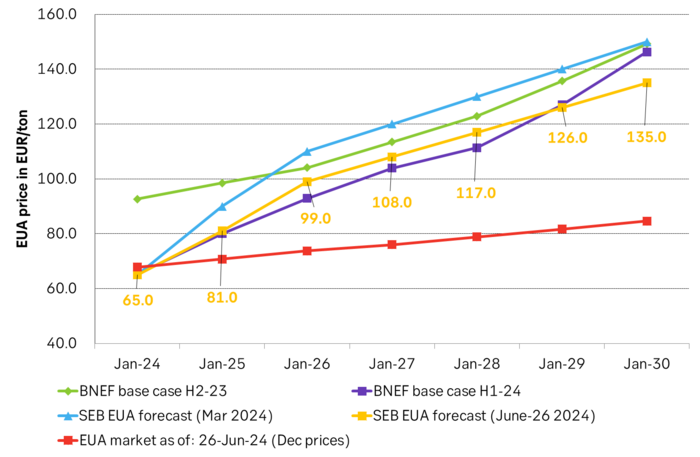
Analys
The most important data point in the global oil market will be published on Friday 28 June


US crude oil production has been booming for more than a decade. Interrupted by two setbacks in response to sharp price declines. The US boom has created large waves in the global oil market and made life very difficult for OPEC(+). Brent crude has not traded below USD 70/b since Dec-2021 and over the past year, it has averaged USD 84/b. US shale oil production would typically boom with such a price level historically. However, there has been zero growth in US crude oil production from Sep-2023 to Mar-2024. This may be partially due to a cold US winter, but something fundamentally seems to have changed. We recently visited a range of US E&P and oil services companies in Houston. The general view was that there would be zero growth in US crude oil production YoY to May 2025. If so and if it also is a general shift to sideways US crude oil production beyond that point, it will be a tremendous shift for the global oil market. It will massively improve the position of OPEC+. It will also sharply change our perception of the forever booming US shale oil supply. But ”the proof is in the pudding” and that is data. More specifically the US monthly, controlled oil production data is to be published on Friday 28 June.
The most important data point in the global oil market will be published on Friday 28 June. The US EIA will then publish its monthly revised and controlled oil production data for April. Following years of booming growth, the US crude oil production has now gone sideways from September 2023 to March 2024. Is this a temporary blip in the growth curve due to a hard and cold US winter or is it the early signs of a huge, fundamental shift where US crude oil production moves from a decade of booming growth to flat-lining horizontal production?
We recently visited a range of E&P and oil services companies in Houston. The general view there was that US crude oil production will be no higher in May 2025 than it is in May 2024. I.e. zero growth.
It may sound undramatic, but if it plays out it is a huge change for the global oil market. It will significantly strengthen the position of OPEC+ and its ability to steer the oil price to a suitable level of its choosing.
The data point on Friday will tell us more about whether the companies we met are correct in their assessment of non-growth in the coming 12 months or whether production growth will accelerate yet again following a slowdown during winter.
The US releases weekly estimates for its crude oil production but these are rough, temporary estimates. The market was fooled by these weekly numbers last year when the weekly numbers pointed to a steady production of around 12.2 m b/d from March to July while actual monthly data, with a substantial lag in publishing, showed that production was rising strongly.
The real data are the monthly, controlled data. These data will be the ”proof of the pudding” of whether US shale oil production now is about to shift from a decade of booming growth to instead flat-line sideways or whether it will drift gradually higher as projected by the US EIA in its latest Short-Term Energy Outlook.
US crude oil production given by weekly data and monthly data. Note that the monthly, controlled data comes with a significant lag. The market was thus navigating along the weekly data which showed ”sideways at 12.2 m b/d” for a significant period last year until actual data showed otherwise with a time-lag.
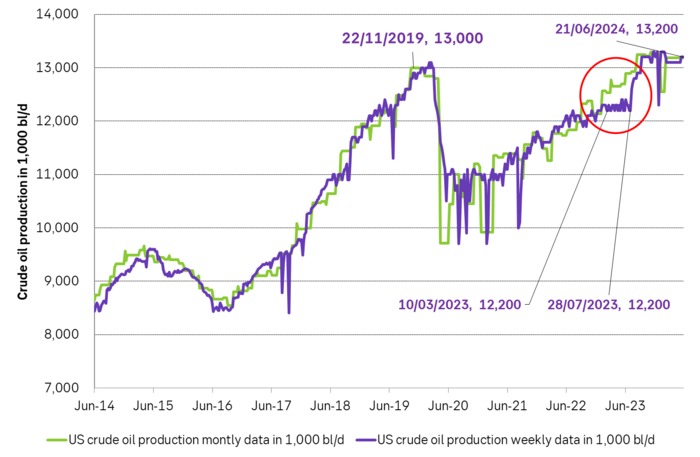
If we add in Natural Gas Liquids and zoom out to include history back to 2001 we see an almost uninterrupted boom in supply since Sep 2011 with a few setbacks. At first glance, this graph gives little support to a belief that US crude oil production now suddenly will go sideways. Simple extrapolation of the graph indicates growth, growth, growth.
US crude and liquids production has boomed since September 2011
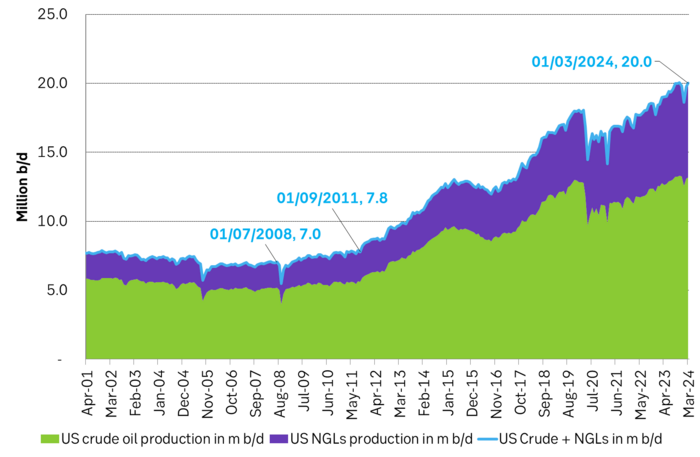
However. The latest actual data point for US crude oil production is for March with a reading of 13.18 m b/d. What stands out is that production then was still below the September level of 13.25 m b/d.
The world has gotten used to forever growing US crude oil production due to the US shale oil revolution, with shorter periods of sharp production declines as a result of sharp price declines.
But the Brent crude oil price hasn’t collapsed. Instead, it is trading solidly in the range of USD 70-80-90/b. The front-month Brent crude oil contract hasn’t closed below USD 70/b since December 2021.
Experiences from the last 15 years would imply wild production growth and activity in US shale oil production at current crude oil prices. But US crude oil production has now basically gone sideways to lower from September to March.
The big, big question is thus: Are we now witnessing the early innings of a big change in US shale oil production where we shift from booming growth to flat-lining of production?
If we zoom in we can see that US liquids production has flat-lined since September 2023. Is the flat-lining from Sep to Mar due to the cold winter so that we’ll see a revival into spring and summer or are we witnessing the early signs of a huge change in the global oil market where US crude oil production goes from booming growth to flat-line production.

The message from Houston was that there will be no growth in US crude oil production until May 2025. SEB recently visited oil and gas producers and services providers in Houston to take the pulse of the oil and gas business. Especially so the US shale oil and shale gas business. What we found was an unusually homogeneous view among the companies we met concerning both the state of the situation and the outlook. The sentiment was kind of peculiar. Everybody was making money and was kind of happy about that, but there was no enthusiasm as the growth and boom years were gone. The unanimous view was that US crude oil production would be no higher one year from now than it is today. I.e. flat-lining from here.
The arguments for flat-lining of US crude oil production here onward were many.
1) The shale oil business has ”grown up” and matured with a focus on profits rather than growth for the sake of growth.
2) Bankruptcies and M&As have consolidated the shale oil companies into larger, fewer public companies now accounting for up to 75% of total production. Investors in these companies have little interest/appetite for growth after having burned their fingers during a decade and a half of capital destruction. These investors may also be skeptical of the longevity of the US shale oil business. Better to fully utilize the current shale oil infrastructure steadily over the coming years and return profits to shareholders than to invest in yet more infrastructure capacity and growth.
3) The remaining 25% of shale oil producers which are in private hands have limited scope for growth as they lack pipeline capacity for bringing more crude oil from field to market. Associated nat gas production is also a problem/bottleneck as flaring is forbidden in many places and pipes to transport nat gas from field to market are limited.
4) The low-hanging fruits of volume productivity have been harvested. Drilling and fracking are now mostly running 24/7 and most new wells today are all ”long wells” of around 3 miles. So hard to shave off yet another day in terms of ”drilling yet faster” and the length of the wells has increasingly reached their natural optimal length.
5) The average ”rock quality” of wells drilled in the US in 2024 will be of slightly lower quality than in 2023 and 2025 will be slightly lower quality than 2024. That is not to say that the US, or more specifically the Permian basin, is quickly running out of shale oil resources. But this will be a slight headwind. There is also an increasing insight into the fact that US shale oil resources are indeed finite and that it is now time to harvest values over the coming 5-10 years. One company we met in Houston argued that US shale oil production would now move sideways for 6-7 years and then overall production decline would set in.
The US shale oil revolution can be divided into three main phases. Each phase is probably equally revolutionary as the other in terms of impact on the global oil market.
1) The boom phase. It started after 2008 but didn’t accelerate in force before the ”Arab Spring” erupted and drove the oil price to USD 110/b from 2011 to 2014. It was talked down time and time again, but it continued to boom and re-boom to the point that today it is almost impossible to envision that it won’t just continue to boom or at least grow forever.
2) The plateau phase. The low-hanging fruits of productivity growth have been harvested. The highest quality resources have been utilized. The halfway point of resources has been extracted. Consolidation, normalization, and maturity of the business has been reached. Production goes sideways.
3) The decline phase. Eventually, the resources will have been extracted to the point that production unavoidably starts to decline.
Moving from phase one to phase two may be almost as shocking for the oil market as the experience of phase 1. The discussions we had with oil producers and services companies in Houston may indicate that we may now be moving from phase one to phase two. That there will be zero shale oil production growth YoY in 2025 and that production then may go sideways for 6-7 years before phase three sets in.
US EIA June STEO report with EIA’s projection for US crude oil production to Dec-2025. Softer growth, but still growth.
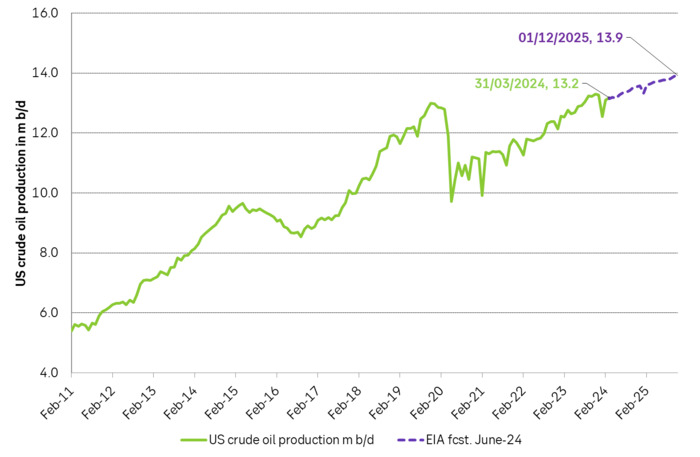
US EIA June STEO report with YoY outlook growth for 2025. Projects that US crude production will grow by 0.47 m b/d YoY in 2025 and that total liquids will grow by 720 k b/d YoY.
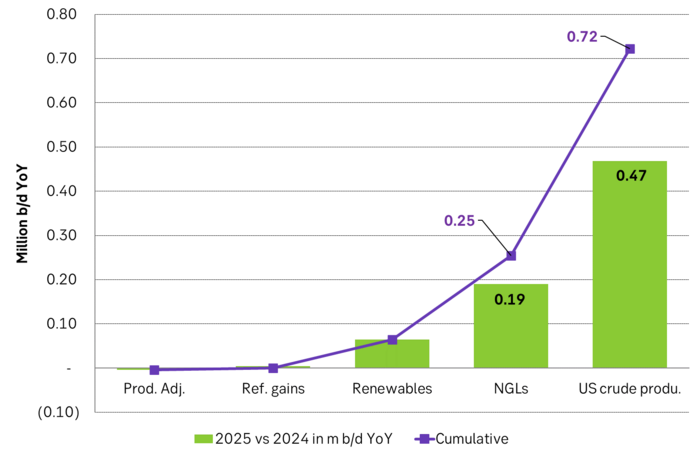
US EIA June STEO report with outlook for production growth by country in 2025. This shows how big the US production growth of 0.7 m b/d YoY really is compared to other producers around the world
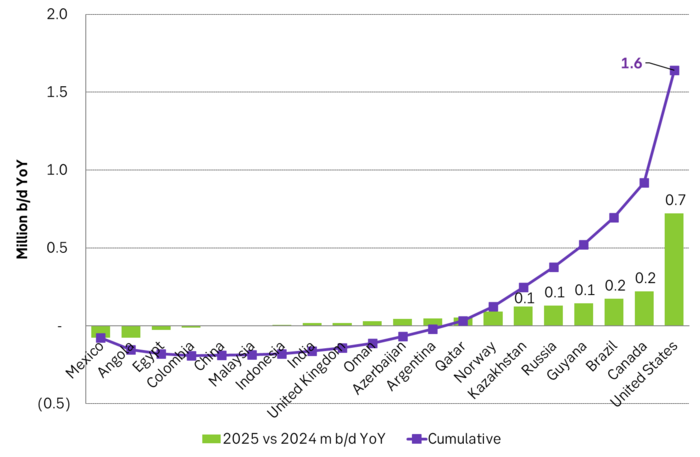
US EIA June STEO report with projected global growth in supply and demand YoY in 2025. Solid demand growth, but even strong supply growth with little room for OPEC+ to expand. Production growth by non-OPEC+ will basically cover global oil demand growth.
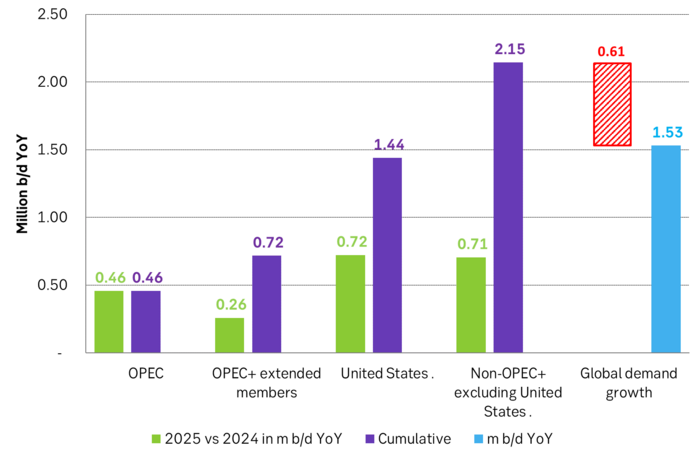
But if there instead is zero growth in US crude oil production in 2025 and the US liquids production only grows by 0.25 m b/d YoY due to NGLs and biofuels, then suddenly there is room for OPEC+ to put some of its current production cuts back into the market. Thus growth/no-growth in US shale oil production will be of huge importance for OPEC+ in 2025. If there is no growth in US shale oil then OPEC+ will have a much better position to control the oil price to where it wants it.
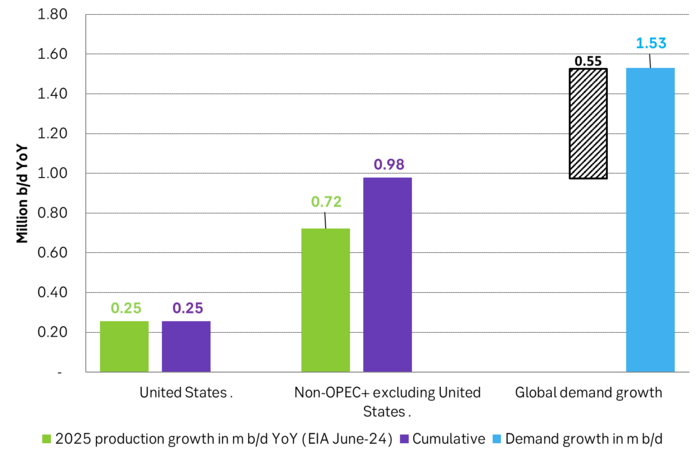
US crude oil production and drilling rig count
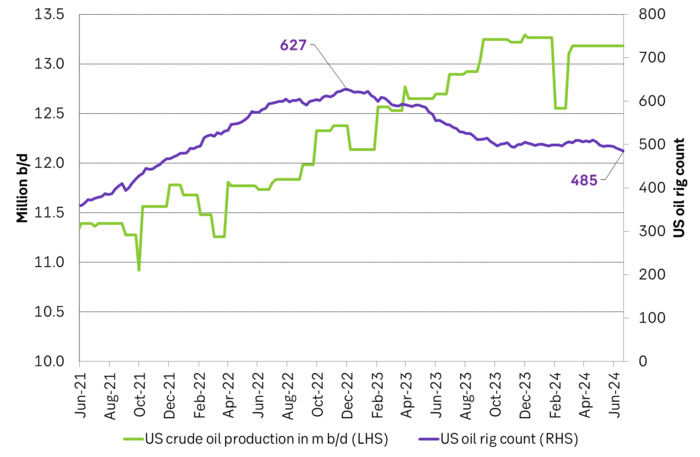
-

 Nyheter7 dagar sedan
Nyheter7 dagar sedanDe tre bästa råvaruvaruaktierna just nu
-

 Nyheter2 veckor sedan
Nyheter2 veckor sedanLundin Mining vill köpa Filo Corp tillsammans med BHP
-

 Nyheter4 veckor sedan
Nyheter4 veckor sedanAfrica Oil är bra att köpa anser Stifel som inleder analysbevakning
-
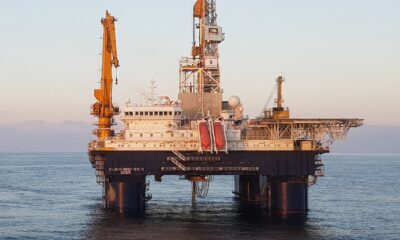
 Nyheter3 veckor sedan
Nyheter3 veckor sedanStor risk att Africa Energy inte överlever det kommande året
-
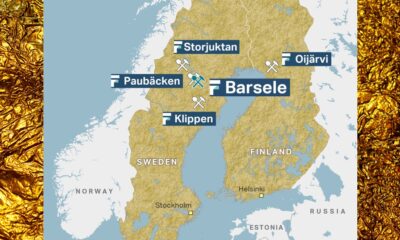
 Nyheter4 veckor sedan
Nyheter4 veckor sedanFirst Nordic Metals har fyra prospekteringsprojekt i Sverige
-

 Analys4 veckor sedan
Analys4 veckor sedanBrent crude inching higher on optimism that US inflationary pressures are fading
-

 Nyheter2 veckor sedan
Nyheter2 veckor sedanUniper satsar på att göra elektrobränsle av sin elektricitet
-

 Nyheter2 veckor sedan
Nyheter2 veckor sedanTre bra aktier inom olja och oljeservice i Kanada


